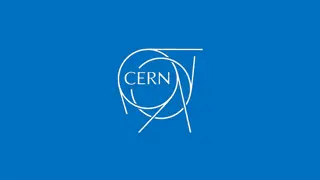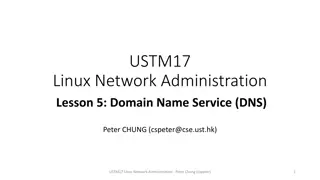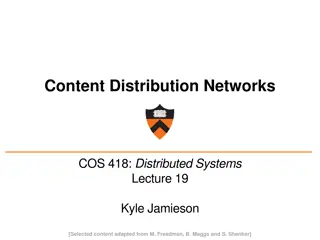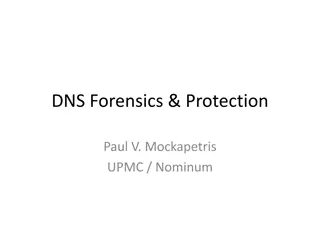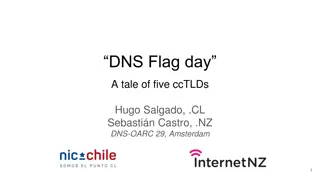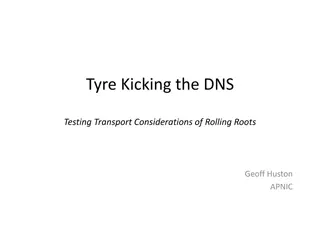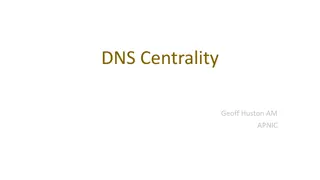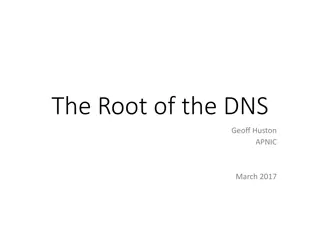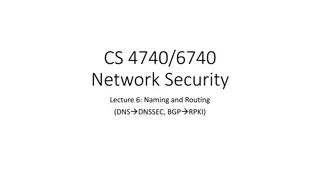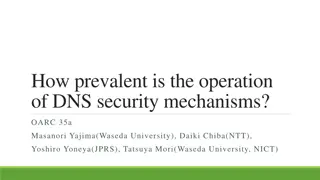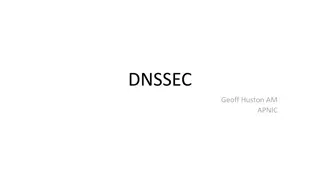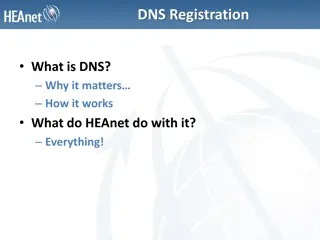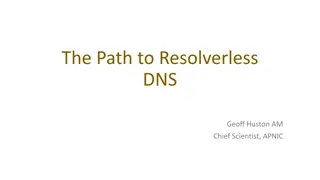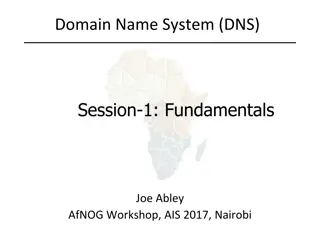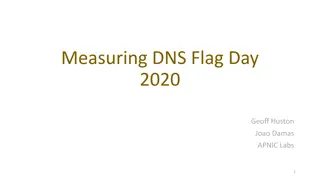
Unveiling the Domain Name System (DNS) and Its Significance
Explore the evolution and importance of the Domain Name System (DNS), from the early days without DNS to the establishment of a distributed database ensuring unique and universal resolvability. Delve into the structure of DNS, its role in translating host names, and the intricate web of Root Servers maintaining top-level domain registries.
Download Presentation

Please find below an Image/Link to download the presentation.
The content on the website is provided AS IS for your information and personal use only. It may not be sold, licensed, or shared on other websites without obtaining consent from the author. If you encounter any issues during the download, it is possible that the publisher has removed the file from their server.
You are allowed to download the files provided on this website for personal or commercial use, subject to the condition that they are used lawfully. All files are the property of their respective owners.
The content on the website is provided AS IS for your information and personal use only. It may not be sold, licensed, or shared on other websites without obtaining consent from the author.
E N D
Presentation Transcript
Lecture 2-2 Domain Name System
Domain Name System (DNS) Developed by Postel & Mockapetris www.internic.net is a good site to browse The phone book of the internet But more restrictive Each entry must be Unique Authentic Universal Resolvability is ensured Distributed Database
History of DNS Early Internet had no Domain Name System Just HOSTS file Win: C:\WINNT\system32\drivers\etc\HOSTS Unix/Linux: /etc/hosts Ancient History: Before DNS, The master HOSTS file was maintained by SRI International Periodically, every computer in the internet reloaded HOSTS file ~1984 someone realized that millions of computers and domains needed a central database DNS was born Still, when a host needs to translate yahoo.com, First, HOSTS file is scanned Then DNS is used.
DNS Tree The DNS Tree Root Zone File TLDs kr uk com org edu co ac icann yonsei med cs
Basic DNS Registry Structure Structure of DNS Structure of DNS
DNS 13 Identical Root Servers All Top Level Domain (TLD) Registries Database for each TLD .com .org .edu .biz . (gTLDs) .fr .ca etc. country-specific TLDs, or ccTLDs Root Servers are Authoritative Maintained by ICANN, www.icann.org (International Corporation for Assigned Names and Numbers)
Map of the Root DNS Servers Click here to see the exact location of Root Servers ( http://www.root-servers.org/ )
Domain Names Hierarchical, right to left nth level . Top Level Domain (Label) yadda.yadda.yadda.yadda .edu TLD, or Label may be up to 63 chars long Total length of name must be <= 255 chars Total length <= 127 labels DNS Names are either Relative (newriver) Fully qualified (newriver.radford.edu, an actual host or server)
DNS Zones The root zone. .edu radford.edu Network Lab in DA214
DNS Servers Each DNS zone has A domain name At least a primary server Probably a secondary server as well A computer that maintains a single master list of DNS Names and IP Addresses for a zone Has Authority for that Zone Is known as the primary server for the zone
nslookup DNS Translation Manual Page for nslookup can be found at http://cr.yp.to/djbdns/intro-dns.html http://www.kloth.net/services/nslookup-man.php It is for Unix shell, but most operation is same for WIN2K or up. The command nslookup allows DNS translation to a DOS cmd window.
nslookup H:\>nslookup Default Server: newriver.radford.edu Address: 137.45.26.19 > ? Commands: (identifiers are shown in uppercase, [] means optional) NAME - print info about the host/domain NAME using default server NAME1 NAME2 - as above, but use NAME2 as server help or ? - print info on common commands set OPTION - set an option all - print options, current server and host [no]debug - print debugging information [no]d2 - print exhaustive debugging information [no]defname - append domain name to each query [no]recurse - ask for recursive answer to query [no]search - use domain search list [no]vc - always use a virtual circuit domain=NAME - set default domain name to NAME srchlist=N1[/N2/.../N6] - set domain to N1 and search list to N1,N2, etc. root=NAME - set root server to NAME retry=X - set number of retries to X timeout=X - set initial time-out interval to X seconds type=X - set query type (ex. A,ANY,CNAME,MX,NS,PTR,SOA,SRV) querytype=X - same as type class=X - set query class (ex. IN (Internet), ANY) [no]msxfr - use MS fast zone transfer ixfrver=X - current version to use in IXFR transfer request server NAME - set default server to NAME, using current default server lserver NAME - set default server to NAME, using initial server finger [USER] - finger the optional NAME at the current default host root - set current default server to the root ls [opt] DOMAIN [> FILE] - list addresses in DOMAIN (optional: output to FILE) -a - list canonical names and aliases -d - list all records -t TYPE - list records of the given type (e.g. A,CNAME,MX,NS,PTR etc.) view FILE - sort an 'ls' output file and view it with pg exit - exit the program
.arpa An explicit way to signal for reverse translation http://cr.yp.to/djbdns/dot-arpa.html Reverse lookups http://cr.yp.to/djbdns/intro-dns.html#reverse

